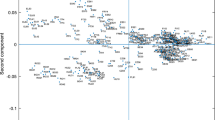Abstract
We present an alternative method to compute the Global Competitiveness Index (GCI) by means of a partial least squares path model. In particular, making use of the same set of variables defined by the World Economic Forum we compute the composite indicator GCI by means of a structural equations model with endogenously derived weights. World Economic Forum, instead, defines GCI as a combinations of subindexes with weights that are fixed but vary according to the stage of development a country belongs to. The main issue we address is whether the weights of the subindexes change according to different stages of development.





Similar content being viewed by others
Notes
We have checked that different possibilities of grouping countries of the transitions stages do not change the following discussion.
For the measurement model, the manifest variables reported in Table 8 were removed from the final model because both corresponding weights and loadings were not validated by the bootstrap procedure.
Authors upon request can provide the measurement model results.
References
Abdi, H., Esposito Vinzi, V., Russolillo, G., Saporta, G., Trinchera, L.: The multiple facets of partial least squares methods. In: Springer Proceedings in Mathematics and Statistics, Springer Proceedings in Mathematics and Statistics, Switzerland (2016)
Becker, J.M., Rai, A., Rigdon, E. E.: Predictive validity and formative measurement in structural equation modeling: Embracing practical relevance. In: Proceedings of the International Conference on Information Systems (ICIS) (2013)
Bollen, K.A.: Structural Equations with Latent Variables. Wiley, New York (1989)
Bollen, K.A., Bauldry, S.: Three Cs in measurement models: causal indicators, composite indicators, and covariates. Psychol. Methods 16(3), 265–284 (2011)
Chin, W.W.: Multi-group analysis with PLS (2000). http://disc-nt.cba.uh.edu/chin/plsfaq/multigroup.htm
Chin, W.W.: A permutation procedure for multi-group comparison of PLS models. Invited presentation. In: Vilares, M., Tenenhaus, M., Coelho, P., Esposito Vinzi, V., Morineau, A. (eds.) PLS and Related Methods, PLS03 International Symposium “Focus on Customers”, Lisbon, pp. 33–43 (2003)
Chin, W.W., Dibbern, J.: An introduction to a permutation based procedure for multi-group PLS analysis: results of tests of differences on simulated data and a cross cultural analysis of the sourcing of information system services between Germany and the USA. In: Esposito Vinzi, V., Chin, W.W., Hensler, J., Wang, H. (eds.) Handbook of Partial Least Squares, Springer Handbooks of Computational Statistics. Springer, Berlin (2010)
Esposito Vinzi, V., Chin, W., Henseler, J., Wang, H. (eds.): Handbook of Partial Least Squares (PLS): Concepts, Methods and Applications, Springer Handbooks of Computational Statistics. Springer, Berlin (2010a)
Esposito Vinzi, V., Trinchera, L., Amato, S.: PLS path modeling: from foundations to recent developments and open issues for model assessment and improvement. In: Esposito Vinzi, V., Chin, W.W., Hensler, J., Wang, H. (eds.) Handbook of Partial Least Squares, Springer Handbooks of Computational Statistics. Springer, Berlin (2010b)
Guinot, C., Latreille, J., Tenenhaus, M.: PLS path modeling and multiple table analysis: application to the cosmetic habits of women in Ile-de-France. Chemom. Intell. Lab. Syst. 58(2), 247–259 (2001)
Hair, J.F., Hult, G.T.M., Ringle, C.M., Sarstedt, M.: A Primer on Partial Least Squares Structural Equation Modeling (PLS-SEM). SAGE, New York (2014)
Hanafi, M.: PLS path modelling: computation of latent variables with the estimation mode B. Comput. Stat. 22(2), 275–292 (2007)
Kaplan, D.: Structural Equation Modeling: Foundations and Extensions. Sage, Thousands Oaks (2000)
Krämer, N., (2007), Analysis of high-dimensional data with partial least squares and boosting. Ph.D. Thesis, Technischen Universität Berlin, Berlin, Germany
Lamberti, G., Banet, T.A.: Invariance test: detecting difference between latent variables structure in partial least squares path modeling. Int. J. Stat. Probab. 6(2), 54 (2017)
Lohmoöller, J.B.: Latent Variable Path Modeling with Partial Least Squares. Springer, Heildelberg (1989)
Noonan, R., Wold, H.: PLS path modeling with indirectly observed variables. In: Jöreskog, K.G., Wold, H. (eds.) Systems Under Indirect Observation: Causality, Structure, Prediction Part II. North-Holland, Amsterdam (1982)
Rigdon, E.E.: Choosing PLS path modeling as analytical method in European management research: a realist perspective. J. Manag. Eur. (2016). https://doi.org/10.1016/j.emj.2016.05.006.
Sanchez, G., Trinchera, L., Russolillo, G.: PLS Path modeling with R (2013). http://cran.r-project.org/web/packages/plspm/index.html
Sarstedt, M., Hair, J.F., Ringle, C.M., Thiele, K.O., Gudergan, S.P.: Estimation issues with PLS and CBSEM: Where the bias lies!. J. Bus. Res. 69(10), 3998–4010 (2016)
Tenenhaus, A., Tenenhaus, M.: Regularized generalized canonical correlation analysis. Psychometrika 76(2), 257–284 (2011)
Tenenhaus, M., Esposito Vinzi, V., Chatelin, Y.M., Lauro, C.: PLS path modeling. Comput. Stat. Data Anal. 48(1), 159–205 (2005)
Welzels, M., Oderkerken-Schröder, G., Van Oppen, C.: Using PLS path modeling for assessing hierarchical construct models: guidelines and empirical illustration. MIS Q. 33(1), 177–195 (2009)
Wold, H.: Soft modeling: the basic design and some extensions. In: Jöreskog, K.G., Wold, H. (eds.) Systems Under Indirect Observation: Causality, Structure, Prediction, vol. 2, pp. 1–54. North Holland, Amsterdam (1982)
Wold, H.: Partial least squares. In: Kotz, S., Johnson, N.L. (eds.) Encyclopedia of Statistical Sciences, vol. 6, pp. 581–591. Wiley, New York (1985)
World Economic Forum: The global competitiveness. Full Data Edition, Editor Klaus Schwab (2013). http://www3.weforum.org/docs/WEF_GlobalCompetitivenessReport_2013-14.pdf
Author information
Authors and Affiliations
Corresponding author
Appendix
Appendix
In this appendix, we report the complete list of manifest variables considered in this work. In particular, in Table 8 we reported variables which have not been validated by the bootstrap procedure of our hierarchical models while in Table 9 there is the list of validated variables.
Rights and permissions
About this article
Cite this article
Petrarca, F., Terzi, S. The Global Competitiveness Index: an alternative measure with endogenously derived weights. Qual Quant 52, 2197–2219 (2018). https://doi.org/10.1007/s11135-017-0655-8
Published:
Issue Date:
DOI: https://doi.org/10.1007/s11135-017-0655-8




